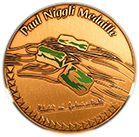Paul Niggli Medal
Paul Niggli Medal 2023
The Paul Niggli Medal 2023 is awarded to Christian Renggli (Institute for Mineralogy, University of Münster; now at Max-Planck Institute for Solar System Research, Göttingen, Germany) in recognition of his outstanding research using experimental methods to understand the properties of gas-solid reactions in volcanic systems on Earth, the Moon and Mercury. The citation from Prof. Stephan Klemme (Universität Münster) and the response of the awardee was published in the Swiss Journal of Geosciences.

The Paul Niggli Medal is Switzerland’s most prestigious “young scientist award” in the Earth Sciences. Since the 100th birthday of Paul Niggli in 1988, it has been awarded annually by the Paul Niggli Foundation, through a committee under the auspices of the Swiss Society of Mineralogy and Petrology. The Paul Niggli Medal honors young geoscientists for outstanding achievements in the fields of mineralogy, geochemistry, petrology, resource geology or solid-earth geophysics and in the technical applications of these fields. The medal and a cash prize are awarded yearly at the plenary session of the Swiss Geoscience Meeting.
The Paul Niggli Foundation
The Paul Niggli Foundation supports and honors young ambassadors of Swiss geoscience. Generous bequests of the families of Paul Niggli (1888-1953), Hedi Fritz - Niggli (1921-2005), Ernst Niggli (1917-2001) and Francis de Quervain (1902-1984) supplemented the initial contribution by Swiss industries, who established the Foundation in 1943.
Many winners of the Paul Niggli Medal have become international leaders in academia or industry, including some of the present members of the Board of the Paul Niggli Foundation. The Board members are nominated by industry, universities and the Swiss Society of Mineralogy and Petrology (SSMP), and presently include:
- Marianne Niggli (Einsiedeln)
- Daniela Rubatto (Bern)
- Luca Caricchi (Geneve)
- Johanna Marin-Carbonne (Lausanne)
- Klaus Holliger (Lausanne)
- Stefan Heuberger (Zürich)
- Thomas Imbach (Zürich)
- Maria Schönbächler (Zürich, president)
Past presidents included Walter Oberholzer, Volkmar Trommsdorff, Thomas Armbruster and Christoph Heinrich.
Nominations
Since 1988, the Paul Niggli Medal is awarded annually, based on proposals from the scientific community. The Board of the Foundation accepts nominations any time and elects a medalist at its annual meeting in spring.
Nomination letters should be accompanied by a curriculum vitae, the publication list of the proposed scientist and possibly additional support letters, which should be mailed to . According to the current statutes, eligible candidates are up to 35 years old or have received their doctorate in the last 6 years. They are either Swiss citizens or have obtained at least two of their academic degrees in the Swiss university system (BSc or MSc and usually their PhD). The award ceremony usually takes place during the plenary session of the annual Swiss Geoscience Meeting.

Paul Niggli
(1888-1953)
A great Swiss mineralogist linking earth sciences with chemistry and physics
Paul Niggli was born on 26th of June 1888 and died on 13th of January 1953. His education began in Zofingen and Aarau, before he took up his studies at ETH Zurich in 1907, which he successfully completed in 1911. His teachers were at that time no lesser than Albert Einstein, Pierre Weiss and several other great scientists. After a brief residency at the Institute of Physical Chemistry in Karlsruhe he was awarded a doctorate at the University of Zurich. Unusual for his time, he further opened his scientific horizon with of post-doctoral research studies overseas, at the Geophysical Laboratory of the Carnegie Institute of Washington. After returning to Switzerland,he submitted his habilitation at ETH Zurich in 1913 and obtained his venia legendi also at University of Zurich shortly after. He then held associate professorships at the universities of Leipzig and Tübingen for a few years.
In 1920, with only 32 years of age, he was elected as the successor of Professor Ulrich Grubenmann, to lead the Institute of Mineralogy and Crystallography in Zürich, in the then new building ‘Naturwissenschaften Ost’ on Clausiusstrasse. He held this joint professorship at ETH Zurich and the University of Zurich for 32 years through to his death in 1953, despite tempting offers from the most significant universities in Germany. He was a founding member of the Swiss National Science Foundation, and for the years of 1928 to 1931 he held the seat of the Rector of ETH Zurich.
Niggli was a crystallographer and mineralogist, but also broad thinker across disciplines in the earth sciences. Starting out from field geology, he worked in mineralogy, petrology, geochemistry, crystal structure systematics and crystal morphology, by linking these fields with quantitative chemistry and physics. He also applied his interests in earth materials research to practical applications including the geology of mineral resources, the behaviour of snow and avalanches and the origin of silicosis disease. In all these areas he has published specialised papers, besides writing several authoritative textbooks. He introduced the concept of geochemical norm calculation, the eponymous "niggli values", which became used all over the world to classify igneous rock compositions. Besides his research and university lecturing, he was deeply engaged in promoting scientific education in schools and the broader community.
In 1948, Paus Niggli was awarded the Roebling Medal of the Mineralogical Society of America, the first European to obtain this highest international honour in the mineralogical sciences. As a further recognition, Dorsum Niggli on the Moon was named after him.
